Rio Rendah
From Aisehman7 August 2007 | 592 Views
 Sarawak will soon have what reports say could be one of the world’s largest aluminium smelters:
Sarawak will soon have what reports say could be one of the world’s largest aluminium smelters:
Global miner Rio Tinto Ltd. and Malaysian conglomerate Cahya Mata Sarawak signed a pact Tuesday to jointly build an aluminum smelter in Malaysia’s eastern state of Sarawak.
Production from the smelting plant on Borneo island will begin in the fourth quarter of 2010 with an initial annual output of 550,000 metric tons, rising to 1.5 million tons over time, the companies said in a statement.
Under the agreement, the companies will undertake a feasibility study to be completed in 18 months, the statement said.
Rio will hold a 60 percent stake in the venture to be known as Sarawak Aluminium Company. The remaining 40 percent will be owned by Cahya Mata, in which the family of Sarawak Chief Minister Abdul Taib Mahmud is a key shareholder.
The smelter will be powered by the 2,400-megawatt Bakun hydroelectric dam due to be completed by 2010. [Associated Press via International Herald Tribune]
The company says the plant will create thousands of jobs and boost the Malaysian economy.
Sure, although I got a feeling that many of those jobs will be taken up by migrant workers.
But that’s not what worries me most.
In case you didn’t know, Rio Tinto is not exactly the world’s most popular company, and aluminium smelting is not exactly an activity that is benign to human health and the environment.
In fact, aluminium smelting consumes humongous amounts of energy:
Besides using one-fifth of the Queensland state’s electricity, around the world, Rio Tinto smelters use one-sixth of New Zealand’s power, a quarter of Tasmania’s and a tenth of Wales’s [New Scientist Environment Blog]
Loads of power, large tracts of land, and cheap labour — Sarawak is just the sort of place that Rio Tinto likes.
There’s also one more fact that makes it and places like the Middle East attractive locations for aluminium smelting:
Why so? It’s a no-brainer. As the company’s head of climate change told me when I asked about the new geography of aluminium smelting: “Abu Dhabi is outside the Kyoto protocol.”
Malaysia is a signatory, but “as a developing country, Malaysia has no quantitative commitments under the Kyoto Protocol at present”, according to the Centre for Environment, Technology and Development Malaysia.
Wonderful, eh?
That’s not all. Sarawak chief minister Taib Mahmud says there’s room for two smelters.
People of Sarawak, enjoy your “development”, Barisan Nasional-style.
BUT MAYBE there’s a way out of this yet.
Is Sarawak a signatory of the Islam Hadhari convention?
Because if it is, Sarawakians can invoke Principle #9, which is “safeguarding the environment”. MERDEKA!
Comment:
15 August 2007 @ 3:17 pm
Rio Tinto evades questions on Bougainville at AGM
Friday 5th May 2006
Rio Tinto evades questions on Panguna at AGM (and affirms riverine waste dumping as ‘best practise’ at the Freeport mine)
Rio Tinto directors evaded questions over whether they would take responsibility for the legacy of environmental problems at the Panguna mine on Bougainville Island, and failed to make any clear commitments that they would engage the Indigenous traditional landowners before continuing discussions over resumption of the operations. While they said they had “no plans’ to reopen the mine, they did admit that discussion where taking place amongst some stakeholders.
The issue is highly charged, given the tens of thousands of lives lost when the environmental problems caused by riverine waste dumping and the exclusion of traditional landowners concerns shut down the mine and lead to a civil war. There remains significant sentiments on the island that the project should never be reopened, and legitimate concerns that failing to respond to community sensitivities could be a receipe for disaster.
Moses Havini, the International representative for Bougainville for the last fifteen years who attended the A.G.M in Melbourne sought commitments for independent environmental studies and acknowledgement of the rights of traditional owners before discussions on the mine could continue, and sought commitments that Rio Tinto would halt any talks until traditional landowners impacted by the mine would be included as equal participants.
Mr. Havini is concerned that the essential commitments and necessary discussions with local people are not taking place.
“Mining companies must radically change their terms of agreement with traditional landowners in the Pacific region. Firstly, further independent environmental impact studies must be carried out before any decisions are made regarding mining in Panguna, or elsewhere. Secondly, the traditional landowners should be given a fair share of any mining venture, and their right to free, prior and informed consent for any developments respected. Thirdly, mining companies in the Pacific must not pump their tailings any more into the river systems or into the seas. Fourthly, the Panguna Landowners Association are still to be fully compensated including arrears by Bougainville Copper Limited, and Fifthly, RTZ must fully commit itself to a full environmental cleanup of toxic materials and chemicals strewn from the Panguna Copper mine to the Port of Loloho” Mr. Havini said.
Rio Tinto said that they were continuing discussions with the other shareholders in the mine and the provincial and P.N.G. national government, but made no commitment that the traditional landowners would be included in these discussions.
With customary landownership by traditional indigenous owners the primary form of landholding across Papua New Guinea and the recent approval of a Constitution for Bougainville that firmly places the ownership of land and resources with the people, Rio’s top down approach, and the question of ownership of the lease itself is unresolved and set to inflame issues.
“One would have hoped that previous experiences would have taught the company that customary indigenous landowners whose lands will be impacted need to be included from day one of any discussions, and their rights to exercise free, prior informed consent over projects on their land acknowledged.” stated Techa Beaumont of the Mineral Policy Institute. “ Rio Tinto has done as much in Australia at mine such as Jabiluka, so why will they not do the same in our neighbouring countries? In the context of what people of Bougainville have suffered as a result of Rio Tinto’s former operations, any other approach shows a reckless disregard for the suffering and loss of life that has occurred.”
Rio Tinto was also under fire for its involvement in the Freeport mine.
“Freeport is contributing to the suffering in West Papua because it funds the Indonesian government and military”, West Papuan refugee Herman Wanggai told the meeting.
“You can’t separate what the mine is doing from the political situation in West Papua. It is directly linked to the human rights problems.”
Claims about the environmental impact of tailings released into the river system, and ongoing breaches of environmental laws were also raised following the release of a report into the mine this week by Indonesian environmental NGO WALHI.
Rio Tinto defended the contraversial practice, which BHP Billiton ruled out ever using again after admitting the environmental disaster it caused at the Ok Tedi mine. Chairman Paul Skinner continued to defend its use at Freeport, saying that the company believed its use was best practice for the operation. He did concede however that they would not consider utilizing it again in any proposal to reopen the Panguna operation.
“Rio’s defense of riverine tailings disposal at Freeport as an example of ‘best practice’ is disturbing,” Minerals Policy Institute Executive Director Techa Beaumont said.
Skinner also refused to answer questions on when the mine would stop breaching Indonesia’s environmental regulations. The breaches led to the Indonesian environment ministry calling on the company to comply with Indonesian laws earlier this year. Mr Witoelar was reported by Reuters news service in April as saying “If they don’t do it (points necessary to comply) then we would give a warning. If they still don’t do it then we will bring them to court.
For more information, please contact:
Techa Beaumont, Executive Director, Mineral Policy Institute 0409 318 406
Moses Havini, International Representative of the Bougainville Autonomous Government: 0409226428
| MALAYSIA: Dirty Dam Draws Dirty Smelters , January 19th, 2006 |
Transnational aluminium smelters, some teaming up with Malaysian partners, are beating a path to eastern Sarawak state with an eye to surplus power from the problem-ridden Bakun Dam. The much-delayed dam in Sarawak, on Borneo island, was originally scheduled for completion in 2003, but is now only expected to gradually generate electricity from late 2009. Faced with soaring electricity tariffs and raw material costs, many aluminium plants have closed shop in the United States and Europe. Major smelters are now scouring the globe for places where electricity is cheap and their sights have narrowed down on Bakun's excess potential even as environmentalists worry about the impact that the dam, and now the smelters, would have on the environment. In particular, smelters from China, the world's largest aluminium user, have been showing a keen interest in Bakun. Last year, over 40 smelters stopped production in China due to higher costs and government moves to curb pollution -- resulting in a loss of more than half a million tons of aluminium. The 2,400 megawatt Bakun hydroelectric dam project was approved by the administration of former premier Mahathir Mohamad in 1994, amidst an outcry that the dam would submerge rainforests covering an area the size of Singapore and displace thousands of indigenous people. Planners ambitiously aimed to channel 70 percent of the dam's generated power across the South China Sea to Peninsular Malaysia by laying over 600 km of submarine cables. It would have been the longest undersea transmission line in the world and an expensive proposition. Local firm Ekran was awarded the contract to manage the project while the construction contract went to the Zurich-based multinational Asea Brown Boveri (ABB). But by 1997, with the onset of the Asian financial crisis and amidst disputes over cost over-runs, the government announced that it was delaying the project and paid compensation to the firms involved. In 1999, it was announced that the dam would be scaled down. The submarine cable idea, its technical feasibility always in major doubt, was scrapped but work on the river diversion tunnels began and have now been completed. In 2001, the government, perhaps mindful of the work already done since 1996, decided to stick to the original 2,400 MW capacity. But without the undersea cables, the economic justification for the dam -- to channel electricity to the more industrialised peninsula -- evaporated. ''It's utterly unnecessary,'' said one Sarawak-based political analyst of the dam, declining to be identified for fear of repercussions. ‘‘The only people who need the dam are the Sarawak politicians and their cronies.'' Moreover, he added, Sarawak has a wealth of alternative energy resources such as natural gas. According to the Bintulu Development Authority, the state has a total known gas reserve of about 50 trillion standard cubic feet. On Bakun, the government faced a stark choice: cut its losses -- some two billion ringgit (0.5 billion US dollars) already spent and prevent any further environmental damage or pour more money -- a further 5-6 billion ringgit (1.3-1.6 billion dollars) -- into an ever-deeper hole. It decided to press on. The government, through an outfit called Sarawak Hidro, took over the management of the project. A Malaysia-China Hydro Joint Venture consortium, led by a Malaysian firm, Sime Darby Berhad, is now constructing the dam. Already, there are reports of cost overruns and delays. But what to do with all that surplus electricity from the dam? After all, Sarawak state itself and neighbouring Sabah have comfortable reserve margins. Electricity demand in Sarawak remains modest (currently under 1,000 MW). Plans to distribute Bakun's power to the rest of Borneo island, which is politically divided among Malaysia, Brunei and Indonesia, never took off. Enter the giant multinationals, teaming up with local firms, seeking approval to build a smelter in Sarawak. The production of aluminium requires a huge amount of electricity, accounting for close to 40 per cent of production costs, which explains why many smelters are built near major sources of electricity supply. One visitor to a popular local current affairs blog summed it up: ''Bakun Dam is the solution to Sarawak's power shortage. But they forgot Sarawak has no power shortage. That's no problem to the dam's promoters: just create a shortage by building an aluminium plant. That way, they succeeded in finding a problem for the solution.'' Even the business weekly, 'The Edge' seemed to agree: ''In Sarawak, the main reason the federal government is allowing an aluminium smelter is to salvage Bakun,'' it said in a candid report. Among those The Edge reported as bidding for approval to build a smelter is local firm Smelter Asia, teaming up with China Aluminium International Engineering, which reportedly wants to set up a 500,000 tonne capacity plant that would consume about half of Bakun's output. Another Malaysia-China consortium is seeking approval for a 3.2 billion dollar smelter. The local firms in this consortium are Cahya Mata Sarawak (CMS) and Press Metal. Giant multinationals reportedly also in the running are Australia-based Rio Tinto Group, BHP Billiton teaming up with Mitsubishi Corp, and the Alcoa Group. Smelter Asia is owned by tycoon Syed Mokhtar Al-Bukhary, who has warm ties with former premier Mahathir Mohamad. CMS, on the other hand, is a well-connected group with diversified interests in Sarawak led by Sulaiman Abdul Taib, the son of the powerful Sarawak chief minister Taib Mahmud. Critics point out that its unit, CMS Cement, which is capable of producing some 2 million tonnes a year, has a near monopoly on cement in Sarawak while another unit, CMS Steel, produces 300,000 tonnes of steel bars and wire rods. In 2004, the group announced that CMS Energy had been awarded a 51 per cent stake in a contract worth RM 130 million (30 million dollars) for the ‘Design and Execution of the Hydraulic Steel Structure Package' of the dam. The group is thus well placed to benefit from the dam's construction work, which requires huge amounts of cement and steel. Apart from the questionable justification for Bakun, environmentalists are worried about the polluting effects of smelters. Smelters emit perfluorocarbon (PFC), which is detrimental to humans, animals and vegetation and has global warming potential. ''Communities in the adjacent areas would be affected by its polluting emissions, once it is built,'' said Wong Meng Chuo, a college lecturer and social activist who spent many years working among communities in Sarawak. ‘‘It is also of concern that the industry would bring changes to the social structure as well as to the cultural practices of the community.'' From experience, he said, such changes are always more of a negative nature since the community is often ill prepared for them. The smelter's impact on the natural environment ‘‘could be devastating, especially in a developing country like ours where law and enforcement is lax''. ''I think it's a dirty industry,'' agreed the political analyst who did not want to be identified. ‘‘We don't need it in Sarawak at a time when the environment has already been terribly degraded through logging and the rivers polluted through siltation and sedimentation.'' This site contains copyrighted material the use of which has not always been specifically authorized by the copyright owner. We are making such material available in our efforts to advance understanding of environmental, political, human rights, economic, democracy, scientific, and social justice issues, etc. We believe this constitutes a 'fair use' of any such copyrighted material as provided for in section 107 of the US Copyright Law. In accordance with Title 17 U.S.C. Section 107, the material on this site is distributed without profit to those who have expressed a prior interest in receiving the included information for research and educational purposes. For more information go to: http://www.law.cornell.edu/uscode/17/107.shtml. If you wish to use copyrighted material from this site for purposes of your own that go beyond 'fair use', you must obtain permission from the copyright owner. |










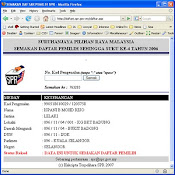





































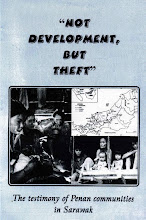
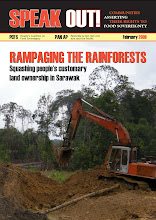





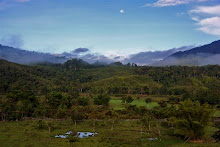



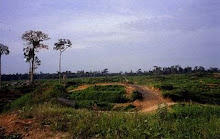

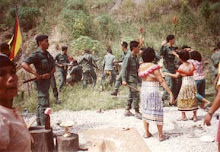





















5 comments:
well...biasala tu..tok uban punya style.....''bless him'' when he died. May God forgive all his mistakes towards sarawakians
Bro, just keep the infos coming. It won't go by unnotice.
hoping for unity in dayaks and don't close your eyes any more!!!!
Aiyo Dayak people. I still remember last election, masa electing eve ...Tok Uban pple "belanja" ur pple some branded boost & some roasted pigs. The next day ur pple end up voting for BN! So salahkan diri sendiri!, dun blame "Malayan" pple.
We leave in the same shit, last election pple in "Malaya" already voted PR, macam mana dengan orang kitak di Sarawak? 16 Sept 2008 jadi penentu.
bila lagi nk kuar dari malaya? reserve minyak tinggal brapa tahun..45 tahun hasil minyak dibalun malaya untuk projek semenanjung..
Post a Comment